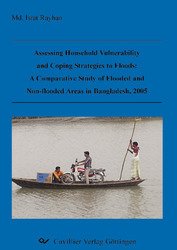| Areas | |
|---|---|
| Serie de libros (96) |
1378
|
| Nachhaltigkeit |
3
|
| Gesundheitswesen |
1
|
| Letra |
2364
|
| Medienwissenschaften | 16 |
| Teología | 57 |
| Filosofía | 102 |
| Derecho | 422 |
| Economía | 850 |
| Ciencias sociales | 416 |
| Ciencias del deporte | 48 |
| Psicología | 233 |
| Educación | 190 |
| Historia | 182 |
| Arte | 111 |
| Ciencias culturales | 166 |
| Literatur | 116 |
| Lingüística | 88 |
| Ciencias Naturales |
5406
|
| Ciencias Ingeniería |
1793
|
| General |
98
|
|
Leitlinien Unfallchirurgie
5. Auflage bestellen |
|
Erweiterte Suche
Assessing Household Vulnerability and Coping Strategies to Floods: (Tienda española)
A Comparative Study of Flooded and Non-flooded Areas in Bangladesh, 2005
Israt Rayhan (Autor)Previo
Indice, Datei (31 KB)
Lectura de prueba, Datei (56 KB)
The frequent occurrence of disastrous floods results in losses for both human life and
property values in Bangladesh. This study thus is set forth to examine the relationships
between socioeconomic conditions and vulnerability to flood hazards. A cross sectional
household survey was carried out two weeks after floods in four districts of Bangladesh
in the year 2005. In total 1050 households in rural areas were interviewed through a three
stage stratified random sampling. Among the four sampled districts, three were affected
by monsoon floods and only one, the Nilphamari district, was affected by a flash flood.
Bivariate analyses depict that floods have significant downside effects on households’
wellbeing, as overall headcount poverty level deteriorates by 17 percent. The worst
welfare loss is measured in Jamalpur district where the majority of households are
involved with agriculture.
A multivariate regression model is carried out that shows that some demographic,
socioeconomic and community variables along with flood shock variables have a
noteworthy impact on flooded and non-flooded households’ income. Estimates of a
multinomial logit model illustrate that flood height, duration and loss of working days are
significant for the poor households’ income deterioration, whereas non-poor households
are significantly affected by flood duration and loss of assets during floods. To assess
households’ vulnerability to floods, this study incorporates four methodologies from the
poverty dynamic literature. Vulnerability estimates from the ‘vulnerability to expected
poverty’ approach depict that flooded households have a higher risk of falling below the
poverty line compared with the non-flooded households. This is the only methodology
out of four used in this study that could estimate households’ vulnerability from crosssectional
data and thereby allowing to estimate non-flooded households’ vulnerability.
The results show that idiosyncratic vulnerability is higher for households affected by
monsoon flood, whereas flash flood worsens households’ covariate vulnerability.
Households involved with agriculture are found to be more vulnerable than other income
groups. The ‘vulnerability to expected utility’ approach illustrates that elimination of
poverty would increase household welfare and thus lessen vulnerability the most. Poverty
and idiosyncratic flood risks are positively correlated and highly significant. Households
with higher educated members, being male-headed and owner of a dwelling place have
been found to be less vulnerable to idiosyncratic flood risks. Possession of arable land
and a small family size can reduce poverty and the aggregate flood risk. The vulnerability
of households from flooded regions, estimated by the ‘vulnerability to poverty line’ and
the Monte Carlo Bootstrap methodologies, shows higher values compared to actual
poverty rates. In this study, stationary environment is assumed with measurement errors
in cross sectional surveyed data, so that the ‘vulnerability to expected utility’ approach
demonstrates better results and closer estimates with respect to actual poverty levels after
floods than the other three methodologies.
This study also deals with the query whether crop diversification would be an option for
mitigating flood risk for farmers and concludes with the finding that mix-crop culture
with cash and staple crops would lessen households’ vulnerability. In the time of the
flooding, rural people in Bangladesh suffer from the lingering effects of labor market
disruption, price fluctuations, and consumption deficiency. Households initiate coping
with borrowing money after the realization of floods and gradually lead to cope with
savings and selling assets as the duration of flood increases, which is illustrated from a
tobit model approach. In addition, empirical analyses explain that the decision to migrate
is often guided by the aspiration to replenish asset values damaged by the floods, as ruralurban
migration emerges as a source of credit. Participation in social networks plays an
important role for the households during flood crisis to get information about potential
host areas for migration.
| ISBN-10 (Impresion) | 3867276501 |
| ISBN-13 (Impresion) | 9783867276504 |
| ISBN-13 (E-Book) | 9783736926509 |
| Formato | A5 |
| Idioma | Inglés |
| Numero de paginas | 226 |
| Laminacion de la cubierta | mate |
| Edicion | 1 Aufl. |
| Volumen | 0 |
| Lugar de publicacion | Göttingen |
| Lugar de la disertacion | Hannover |
| Fecha de publicacion | 22.07.2008 |
| Clasificacion simple | Tesis doctoral |
| Area |
Economía
|
| Palabras claves | Überschwemmungen, Verwundbarkeit, Bewältigungsstrategie |








